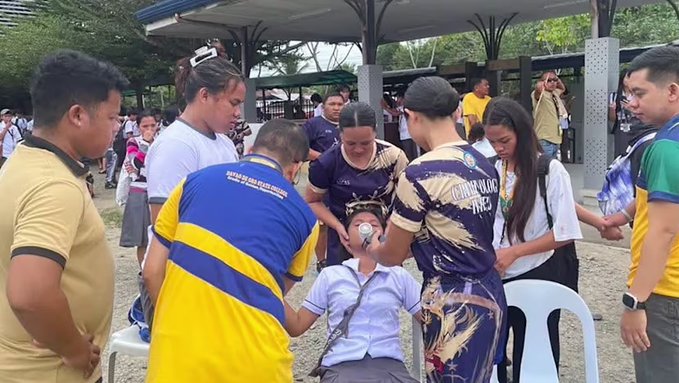
Philippines Earthquake Tsunami Alert: A Morning of Panic
A Philippines earthquake tsunami alert gripped Mindanao on October 10, 2025, after a 7.5 magnitude quake struck at 9:43 a.m. Coastal towns plunged into chaos as sirens blared, urging residents to flee inland with loved ones and essentials. Although the tsunami threat eased by midday, the quake’s devastation lingers, testing the Philippines’ resilience on the volatile Ring of Fire.
The epicenter, 23 kilometers deep in the Philippine Sea, sent tremors through Davao Oriental and nearby provinces. Buildings swayed, windows shattered, and power lines collapsed. Social media captured the fear: cracked walls in Surigao del Sur, kids hiding under desks in Davao City. The Philippines earthquake tsunami alert drove thousands to higher ground, amplifying the morning’s terror.
For a nation accustomed to seismic risks, this felt raw. Families grabbed emergency bags. Schools evacuated swiftly. Roads clogged as coastal dwellers fled. An X post showed a toppled market stall in Mati City. Another captured streetlights swaying wildly. The alert reminded Filipinos: when the earth moves, preparation meets panic.
Philippines Earthquake Tsunami Alert: Devastation and Determination
Damage reports poured in fast. In Hinatuan, a two-story home collapsed. Its owner, a fisherman named Ramon, barely escaped. “The earth roared,” he told reporters later. Nearby, a church steeple toppled into the street. Power outages blacked out entire barangays. Water mains burst, flooding low-lying roads. At least one person died in the chaos—a woman crushed by falling debris in a market. Two others suffered serious injuries from the jolts.
Moreover, aftershocks kept nerves frayed. Smaller quakes, up to 4.5 magnitude, followed within hours. They rattled windows and hearts alike. Schools closed indefinitely. Businesses halted operations. The economic toll? Early estimates peg it at millions of pesos. Farmers worried about ruined crops. Fishermen eyed the sea warily, even after the all-clear.
Transitioning to the human side, stories emerged of quiet heroism. A teacher in Baganga guided 30 students to safety. She used songs to calm their cries. “We sang until the shaking stopped,” she recalled. Community centers became hubs for the displaced. Neighbors shared rice and stories under dim lantern light. In these moments, resilience shone brightest.
Tsunami Warning Response: Swift Action, Lingering Gaps
The real terror stemmed from the sea. PHIVOLCS, the Philippine Institute of Volcanology and Seismology, issued the alert swiftly. They predicted waves up to three meters high. Evacuations swept coastal towns. Boats bobbed empty in harbors as owners ran inland. Indonesia and Palau got warnings too, given the quake’s reach.
However, nature held back. The first waves arrived mild—mere surges under a meter. By noon, monitors showed no major threat. The Pacific Tsunami Warning Center lifted the advisory around 2 p.m. Relief washed over faces like a gentle tide. “We prepared for the end,” said a mother from Mati City. “Now, we rebuild.”
This swift end highlights smart systems at work. Sirens, apps, and drills paid off. Yet, gaps linger. Some remote villages got late notices. Radios crackled with static. Cell signals dropped amid the panic. Officials now probe these flaws. How can tech reach everyone faster? Lessons from 2025’s Philippines earthquake today tsunami could save lives next time.
Government and Global Aid: Unity in Action
President Ferdinand Marcos Jr. sprang into gear. He declared a state of calamity for affected areas by midday. Aid convoys rolled out with tents, food, and medics. The Department of Social Welfare and Development mobilized 50,000 family packs. “We’re with you,” the president assured in a televised address. Military helicopters airlifted supplies to hard-hit spots.
Additionally, international partners stepped up. The U.S. Embassy issued alerts and offered expertise. Japan pledged seismic aid, drawing from its own quake history. Locally, Red Cross volunteers fanned out. They treated cuts and soothed shaken souls. By evening, temporary shelters housed hundreds. Psychologists arrived to tackle trauma, especially for kids who saw their world crack open.
Critics, though, point to bigger issues. Infrastructure strains under frequent quakes. Many buildings lack retrofits. Codes exist, but enforcement lags in poor zones. “This isn’t just nature’s fury,” argued environmentalist Lila Santos. “It’s our neglect catching up.” Calls grow for tougher standards. Funds for quake-proof homes. Better early warnings.



